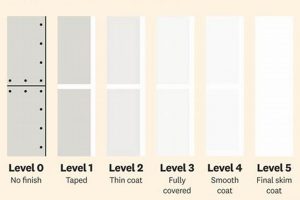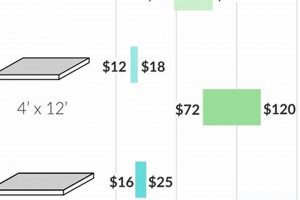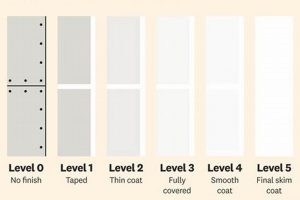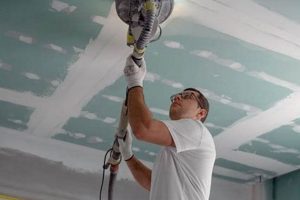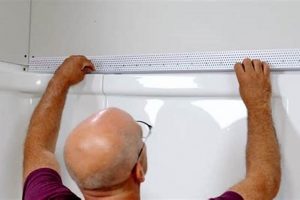This surface preparation standard involves taping drywall seams and applying a single coat of joint compound over the tape and fasteners. The resulting surface is then wiped down, but not sanded smooth. It is generally specified in garages, warehouses, or other areas where aesthetic refinement is not a primary concern. For example, a storage area behind a retail space may receive this level of finish.
The value of this preparation lies in its efficiency and cost-effectiveness. By minimizing the labor and materials required, it offers a practical solution for environments where durability and functionality are paramount over visual appeal. Historically, this approach reflects a pragmatic response to balancing construction budgets with the need for basic wall protection in less visible or heavily trafficked locations.
Understanding the characteristics of this preparation is key to selecting the appropriate finish for a given project. Factors such as cost, desired aesthetic, and intended use of the space will all play a significant role in determining whether this particular preparation is suitable, or if a higher level of finishing is required.
Essential Considerations
The following recommendations are crucial when implementing this method. Careful adherence to these guidelines can minimize future complications and ensure a satisfactory outcome, given the intended application.
Tip 1: Joint Compound Application: Apply the first coat of joint compound evenly, ensuring full coverage of the tape and fasteners. Uneven application can lead to visible imperfections even under subsequent coats, should a higher finish level be desired later.
Tip 2: Fastener Depth: Countersink screws and nails to the appropriate depth, without breaking the paper facing of the drywall. Protruding fasteners will be visible and compromise the integrity of the surface.
Tip 3: Tape Embedding: Ensure drywall tape is fully embedded in the joint compound. Air pockets or loose tape will result in bubbling or cracking over time, requiring costly repairs.
Tip 4: Surface Preparation: Prior to application, ensure the drywall surface is clean and free of dust or debris. This promotes better adhesion and prevents contaminants from becoming embedded in the joint compound.
Tip 5: Environmental Conditions: Avoid application in excessively humid or cold conditions. Extreme temperatures and humidity can affect the drying and curing process of the joint compound, leading to cracking or poor adhesion.
Tip 6: Tool Selection: Employ appropriate tools, such as a taping knife and mud pan, to facilitate even and efficient application of the joint compound. Using incorrect tools can lead to a less uniform finish.
Tip 7: Feathering Edges: Feather the edges of the joint compound to minimize noticeable transitions. This creates a smoother, more blended appearance, even though sanding is not performed.
By meticulously attending to these details, one can maximize the benefits of this preparation, achieving an acceptable level of surface preparation for utilitarian spaces. Prioritizing careful execution results in better outcomes.
Moving forward, understanding the differences between the preparation and higher levels is important in the broader context of drywall finishing.
1. Minimal Sanding Required
The defining characteristic of requiring minimal sanding directly impacts the speed and cost of achieving that preparation. The reduced labor input distinguishes it from more refined finishing approaches.
- Labor Cost Reduction
Because minimal sanding is necessary, the time spent preparing the wall surface decreases significantly. This directly translates to lower labor costs, making the specified preparation an economically viable choice for large-scale projects or areas where budgetary constraints are paramount. For instance, in a large warehouse where extensive drywall installation is needed, minimizing sanding can lead to substantial savings without significantly compromising functionality.
- Material Consumption
The necessity for less sanding also reduces the consumption of abrasive materials like sandpaper. This not only lowers material costs but also reduces the amount of dust generated during the finishing process. Less dust contributes to a cleaner work environment, minimizing cleanup time and potential health hazards associated with prolonged exposure to drywall dust.
- Surface Imperfections
While minimal sanding reduces costs, it also implies that minor surface imperfections may remain visible. This level of preparation is acceptable where aesthetics are not a primary concern, such as in storage areas or garages. However, in areas where a smooth, seamless appearance is desired, additional sanding and finishing are necessary to achieve a higher level of surface preparation.
- Suitability for Specific Applications
The degree of sanding makes it well-suited for utilitarian applications. The small blemishes don’t distract from functionality. However, in retail spaces where a smooth and attractive wall finish is essential for creating a positive customer experience, the minor imperfections might detract from the overall aesthetic, necessitating a higher level of finishing.
The implication of minimal sanding, therefore, is a trade-off between cost-effectiveness and aesthetic quality. It is a pragmatic solution for spaces where functionality outweighs visual appeal, while higher standards require more extensive sanding to achieve a smoother, more refined surface. The choice, consequently, is dependent on the particular requirements of the project and the intended use of the space.
2. Single joint compound coat
The application of a single coat of joint compound is a defining characteristic, directly influencing the final appearance and suitability of the prepared surface. This limited application offers a balance between cost-effectiveness and basic seam concealment.
- Cost Minimization
The primary advantage is the reduction in labor and material expenses. Applying a single coat significantly cuts down on the time required for finishing, reducing labor costs. Similarly, less joint compound is used, lowering material costs. A large project, such as a warehouse, illustrates this cost-effectiveness. The cumulative savings across thousands of square feet can be substantial.
- Aesthetic Implications
The resulting surface exhibits a minimal level of refinement. While the single coat conceals tape and fasteners, imperfections such as minor ridges and unevenness may remain visible. These aesthetic compromises are generally acceptable in utilitarian spaces, such as garages or storage areas, where appearance is not a priority. However, such a finish is inappropriate for areas where a smooth, flawless surface is desired.
- Time Efficiency
The reduced application time directly contributes to faster project completion. A single coat dries faster than multiple coats, accelerating the overall finishing timeline. In time-sensitive projects, this efficiency is highly valuable. For example, the quicker turnaround enables faster occupancy of a newly constructed warehouse, maximizing revenue potential.
- Surface Preparation Limitations
The absence of subsequent coats means that imperfections and unevenness cannot be adequately corrected. Any underlying inconsistencies in the drywall installation will be more pronounced with a single coat application. This approach is unsuitable for walls with significant imperfections or those requiring a high degree of smoothness. In such cases, more extensive surface preparation techniques are required.
The decision to use a single coat of joint compound must therefore consider the trade-offs between cost, appearance, time, and surface quality. This technique provides a basic level of preparation for utilitarian spaces where functionality outweighs aesthetics. It is not an adequate solution for areas requiring a refined or seamless finish.
3. Exposed fasteners acceptable
The acceptance of exposed fasteners constitutes a significant aspect of the specified drywall surface preparation, directly influencing both the labor requirements and the aesthetic outcome. This acceptance signifies a reduced emphasis on visual refinement, prioritizing functionality and cost-effectiveness.
- Reduced Labor Requirements
The tolerance for visible fasteners minimizes the time spent on meticulous patching and concealing. Laborers need only ensure the fasteners are properly seated but are not required to spend additional effort hiding them with multiple coats of joint compound and sanding. This contributes to faster project completion and reduced overall labor costs. For instance, in a large warehouse project, accepting visible fasteners can save considerable time and resources.
- Impact on Aesthetic Appearance
The presence of exposed fasteners inherently creates a less polished aesthetic. Visible screw or nail heads disrupt the smooth, uniform surface achieved with higher levels of drywall finishing. This trade-off is acceptable in spaces where aesthetic concerns are secondary, such as storage areas, utility rooms, or unfinished basements. However, in areas where visual appeal is important, the resulting surface would be considered unsatisfactory.
- Cost-Effectiveness Considerations
Allowing exposed fasteners directly reduces material and labor costs associated with achieving a higher level of finish. Eliminating the need for extensive patching and sanding lowers the overall project budget, making it a viable option for projects with limited resources. Accepting this condition enables a more economical approach to wall preparation without sacrificing essential functionality.
- Functional Implications
While exposed fasteners may detract from the aesthetic appearance, they generally do not compromise the structural integrity or functionality of the wall system. As long as the fasteners are properly installed and seated, they provide adequate support for the drywall panels. The focus shifts from achieving a flawless finish to ensuring a secure and functional wall surface.
The acceptance of exposed fasteners is therefore a deliberate choice that reflects a prioritization of cost-effectiveness and functional requirements over aesthetic considerations. This characteristic defines the economical nature of this preparation and its suitability for spaces where visual refinement is not a primary concern. By understanding the implications of visible fasteners, one can make informed decisions about the appropriate level of drywall finishing for specific project requirements.
4. Warehouses, garages suited
The suitability of warehouses and garages for a specific type of drywall finish arises from a pragmatic alignment of functional requirements and cost considerations. These spaces prioritize utility over aesthetic refinement, making a particular level of surface preparation an economically viable option.
- Minimal Aesthetic Requirements
Warehouses and garages generally serve as storage or work areas where visual appeal is secondary. The primary focus is on functionality and durability. Surfaces in these spaces are often subjected to heavy use, impacts, and potential exposure to moisture or chemicals. A highly refined finish would be both unnecessary and impractical, as it would quickly degrade under such conditions.
- Cost Optimization
Construction and maintenance costs are critical factors in warehouse and garage settings. Opting for a simpler finish minimizes labor and material expenses, allowing resources to be allocated to other essential aspects of the building, such as structural integrity, security, and climate control. The economic benefits are particularly significant in large warehouse facilities where extensive wall areas require finishing.
- Durability Considerations
While the finish is not designed for aesthetic appeal, it still provides a degree of surface protection against minor impacts and abrasion. The single coat of joint compound helps to seal the drywall seams and protect the paper facing from damage. This is especially important in garages where tools, equipment, and vehicles can potentially come into contact with the walls.
- Simplified Maintenance
Lower level finishes are easier and less expensive to repair or repaint compared to more refined surfaces. In warehouses and garages, where minor damage is common, the ability to quickly and easily patch up imperfections is a practical advantage. This reduces downtime and minimizes the overall cost of maintaining the wall surfaces.
Therefore, the selection of this specific type of drywall finish for warehouses and garages reflects a strategic decision to balance functionality, durability, and cost-effectiveness. While the resulting surface may not be visually striking, it provides an adequate level of protection and concealment for these utilitarian spaces, while minimizing expenses and simplifying maintenance.
5. Cost-effective solution
The designation of a “cost-effective solution” is intrinsically linked to the application of level 2 drywall finish. This association stems from the minimized material and labor requirements inherent in the surface preparation method. The absence of extensive sanding and the use of only one coat of joint compound directly translate to reduced expenditures. This is particularly salient in large-scale projects, where the aggregate savings on materials and labor hours become substantial. For instance, in the construction of a distribution center, the specified finish on vast interior walls results in significant budgetary advantages without unduly compromising the functionality of the space.
This approach represents a pragmatic choice for areas where aesthetic considerations are subordinate to practical needs. Warehouses, storage facilities, and garages exemplify such spaces. The reduced finishing effort aligns with the intended use of these areas, where durability and functionality supersede visual appeal. Further cost savings are realized in reduced maintenance requirements, as minor imperfections are tolerated and repairs are less demanding compared to higher finish levels. This is relevant to commercial property management, where long-term operational costs are a primary concern.
The understanding of this connection is crucial for project managers and contractors aiming to balance budgetary constraints with functional requirements. By recognizing the cost-effective nature, informed decisions can be made regarding the appropriate level of surface preparation for specific applications. The inherent trade-off between cost and aesthetic refinement must be carefully considered. The utilization of level 2 finishing offers a viable solution for projects where economy is a paramount factor without sacrificing the essential protective function of the wall system.
Frequently Asked Questions
The following questions address common concerns and misconceptions regarding the specified drywall surface preparation, providing clarity on its application, limitations, and appropriate usage.
Question 1: What distinguishes this method from higher levels of drywall finish?
The primary difference lies in the number of joint compound coats, the extent of sanding, and the acceptability of visible fasteners. Higher levels involve multiple coats, extensive sanding for a smooth surface, and complete concealment of fasteners. This finish, by contrast, involves a single coat, minimal sanding, and permits exposed fasteners.
Question 2: In what types of buildings or spaces is this level typically specified?
This approach is commonly used in utilitarian spaces such as warehouses, garages, storage facilities, and service corridors. These areas prioritize functionality and cost-effectiveness over aesthetic appeal, making a simpler finishing approach an appropriate choice.
Question 3: What are the primary advantages of selecting the level 2 drywall finish?
The chief advantages are reduced material costs, lower labor expenses, and faster project completion. Minimal sanding and a single coat of joint compound significantly decrease the time and resources required compared to higher levels of finish.
Question 4: Are there any specific limitations associated with this level?
The most notable limitation is the presence of visible imperfections and a less refined surface. Minor ridges, unevenness, and exposed fasteners may be apparent. This finish is unsuitable for areas where a smooth, seamless appearance is desired.
Question 5: Can a level 2 finish be upgraded to a higher level at a later date?
Yes, it is possible to upgrade. Additional coats of joint compound, sanding, and fastener concealment can be performed to achieve a smoother, more refined surface. However, the cost and effort involved may be greater than if a higher level had been specified initially.
Question 6: Does this preparation meet building code requirements?
The compliance with building codes depends on the specific regulations in the relevant jurisdiction. It is important to consult local building codes and authorities to ensure that the specified finish meets the applicable requirements for the intended use of the space.
Understanding these frequently asked questions provides a comprehensive overview of the specified level, enabling informed decisions regarding its suitability for specific projects.
The subsequent section explores the potential pitfalls associated with improper execution.
Level 2 Drywall Finish
The preceding discussion has illuminated the characteristics, benefits, and limitations inherent in level 2 drywall finish. This surface preparation method, defined by minimal sanding, a single coat of joint compound, and the acceptance of exposed fasteners, represents a pragmatic compromise between cost and aesthetic refinement. Its suitability for utilitarian spaces such as warehouses and garages underscores its value in projects where functionality outweighs visual appeal.
However, the decision to employ this finish level must be made with careful consideration of the intended use of the space and the potential for future modifications. While it offers immediate cost savings, neglecting to account for long-term aesthetic requirements or the possibility of upgrading to a higher finish level can lead to increased expenses and complications down the line. Therefore, a thorough assessment of project needs is essential to ensure that the chosen approach aligns with both present and future demands.


